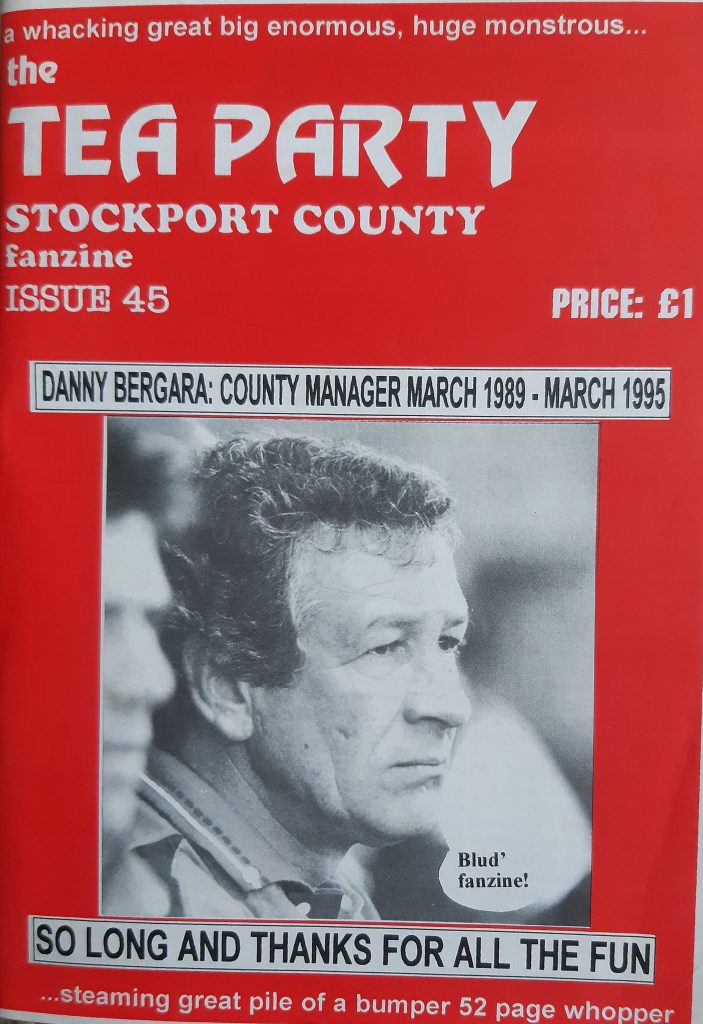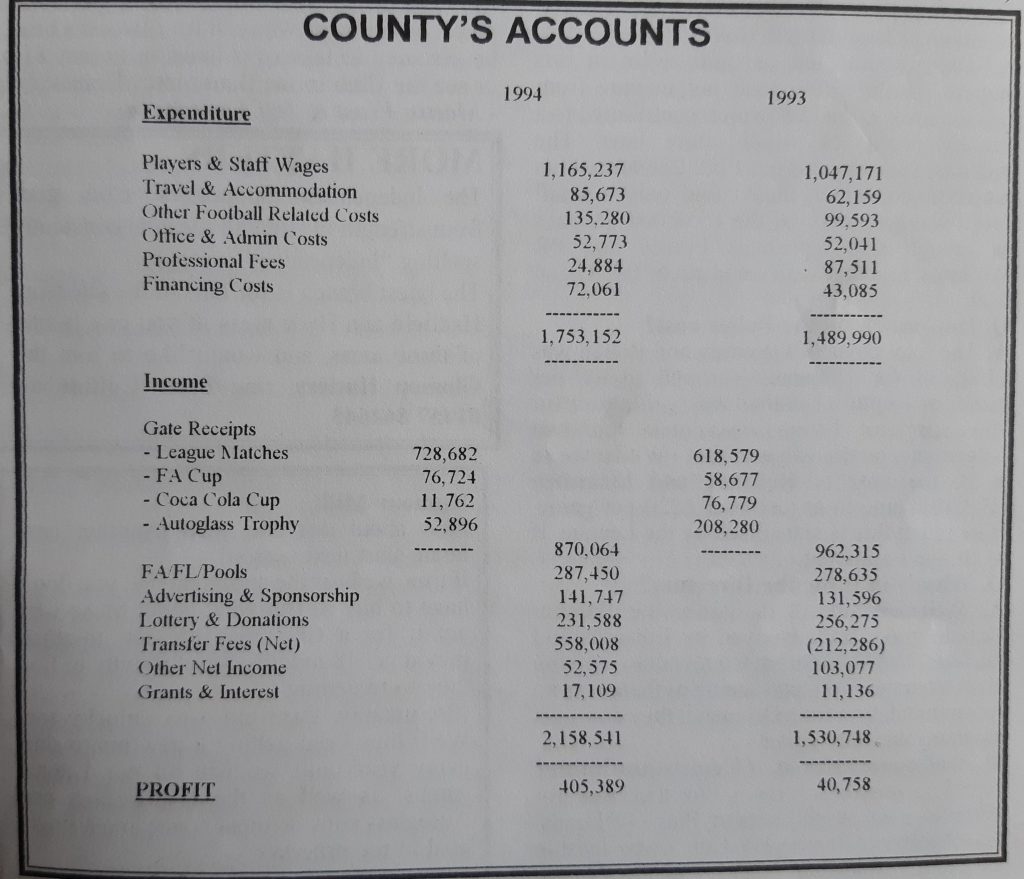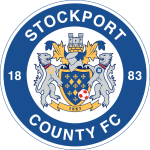MONEY MATTERS – YOUR QUESTIONS ANSWERED
..

Financially things had improved at EP under Elwood’s stewardship, but the absence of any meaningful communication from the Club led to lots of questions being asked. I got hold of a set of accounts for the 1993/94 financial year, and looked at answering questions which had been frequently posed in the pages of TTP
..
*************
There’s a fair amount of supposition in the pages of TTP regarding the finances of the club – about transfer fees, the cost of stands, the purportedly tight wage structure and so forth. Getting confirmation of any of this information is nigh on impossible. However as a limited company the Club is obliged under law to present its annual accounts to the annual meeting of shareholders and thence is also obliged to lodge those at Companies House. Admittedly the information produced for the shareholders at the AGM in February related to the financial year ended 30th June 1994 was therefore some 7 or 8 months out of date but it still gives an illuminating insight into the finances of the club. What can we find out?
Who actually owns County?
Under law it’s the shareholders. The total share capital of the club is 40,000 shares at £1 each. Of these all but 49 have been issued. Of the directors, Baker has 1,320, Rains has 2,090, White 1,255. Taylor 20, and Jolley 22. However, with 30,000 shares and a 75% holding it’s Elwood who has the final say. Just over 5,000 shares are held by other individuals but their only say in the club is being able to attend and vote at AGM’s.
We hear a lot about how much cash has been put into the club by directors past and present. What’s the position on this?
Well the accounts don’t show anything specific to individuals. However, as at 30/6/94 total loans outstanding amounted to £1,187,176 of which only £20,995 were secured, (presumably against the land and buildings owned by the club). Some of the loans carry interest, although the accounts are very specific in noting that these relate to EX-directors. One of these is due to be repaid in November 1995. The rest of the loans don’t carry any interest and are unsecured. It’s likely that these relate substantially to the cash that Elwood has put in. So the rumours that his money is safe and is tied up against the ground are not true. The auditors make specific reference to these loans in their report. They have prepared the accounts on the basis that the Club is a going concern. However they state continuation of this loan finance is fundamental to this assumption. Basically if Elwood pulled the plug and took his money out and there is no replacement of it, the Club would go bump pretty quickly
Who else could pull the plug?
In theory anybody to whom the club owes money. In practice the bank would have a fair pull in the event of any default on repayments of loans made. On 30/6/94 the total owed to the bank amounted to £237,788 and it looks as though a repayment schedule has been negotiated. Of the total only £61,068 is due to be repaid by the middle of 1996 – the rest of it will be repaid over a period greater than five years. It looks as though a commitment has been made to repay £4,100 per month. Presumably all the time anything is outstanding interest will accrue. The Inland Revenue and Customs & Excise generally have influence as well and it looks as though they were owed £83,438 at the end of June last year. There’s also the huge sum of £471,744 owed to trade creditors – it’s difficult to determine what this can be. It should relate to the basic operation of the club, (transfer fees and so on), but given the fact that we haven’t paid any fee of note at the time of the accounts it looks as though it’s made up of a fair few things with one of the largest being the work done on the pitch last summer.
We hear a lot about sponsorship and so on. How much is it worth?
On the face of it the Club does reasonably well in this field. If we go back no more than 7 years our income was next to nil. In the year ending 30/6/94 advertising and sponsorship raised £141,747 and the Lottery £231,588. On average that amounts in total to £7,000 per week which must go asignificant way towards meeting with standing overheads that the Club has.
..

..
Is the shop worth having?
The way the shop is accounted for is interesting. Nowhere in the accounts can we determine the gross sales – everything is shown net. As the wages of shop staff are also shown elsewhere it looks as though the shop makes a profit of £52,575 although this figure might include programme profits as well. Whatever the case it looks alright although that must be a bit of concern that the comparative figure for the previous year was £103,077.
The commercial side looks as though it does well, but much does it contribute in relation to gate money?
The commercial setup contributes in excess of £400,000 a year. On the other hand gate money is more than that. Season ticket sales amount to £96,092 with £648,602 coming from pay on the gate fans. Altogether after the Football League have had their cut County’s net income through the gate is £728,682 or if you prefer around £31,000 a game.
Surely we get something from the various cups?
You only get from the Cups to the extent that you progress in them. In 1993 we did well in the FA Cup, (QPR, Bristol City), and our share after the visitors and FA had a cut was £76,724. The previous season, (a round fewer but Derby), our share was £58,677. On the other hand the Coca-Cola, (lost to Hartlepool in the 1st round), gave us £11,762 as against £76,779 the previous year, (Forest). The value of the Autoglass Finals is also shown. In 1993/94, (lost to Huddersfield), the competition brought us £52,896 – 1992/93, (Wembley final against Vale), gave us £208,820. Cup runs are great financially but no one should ever bank on them – the icing on the cake as far as the bank manager is concerned
On the subject Friday football we’re always told that will lose out on the pools money – how much is this worth?
I’m afraid the accounts don’t tell us. We know that overall the handout from the FA, the League and the Pools amounts to £287,450 which again is hardly to be sniffed at. This figure presumably includes our share of the play-off proceeds.
We’re a lower division side having to sell to survive. How true is this?
The accounts tell us quite a lot in this respect. In 1993 total net income from transfers was £558,008 which contributed to a healthy profit of which more later. The previous year we paid out £212,286 more than we received which meant that only a small profit was recorded. Of the £558,008 it looks as though this represents Preece and PR Williams together with some cut of the Angell deal.
How much do the police cost?
The total costs of gateman and police was £102,334 for 31 games – around £3,300 per game, or to put it another way getting on for 70p a spectator. I suppose you make your own judgments on the value of that. Whilst we’re at it the cost of referees and linesmen, (£7,040) came in at just over £220 per game . How much this is subsidised by the League, if at all, isn’t apparent
What’s in it for the directors?
Well, Division 2 is hardly the Premier League gravy train enjoyed by Edwards and the like. The directors at County draw nothing at all from the club and seeing as there was no recommendation for a dividend they don’t get anything that way either.
Well come on then, is County profitable?
The answer is yes but that was for 1993/94, a successful season, play off finals, reasonable run in the FA Cup, two sizeable outgoing transfers and an effective commercial setup.
One thing that is clearly evident is that County, presumably as with all other clubs, cannot ever hope to live by gate money alone. Advertising, sponsorship, and the lottery are the lifeblood when associated with success on the field. Without the incoming transfer fees in 1993/94, the club would have sustained a loss of around £150,000 which compared to some clubs maybe a drop in the ocean but is still a way to a sticky end. For our purposes in looking at the accounts it is a fair summary to say that Elwood has over recent years improved the financial standing of the club immeasurably- it is now being run as a going concern. We must be aware, however, that it is the unsecured loans which have underpinned the club whilst this improvement has taken place. So for those who call for Elwood’s head be prepared to takeover loans in excess of £1m or see the club in the bankruptcy courts.
..
April 1995


Recent Comments